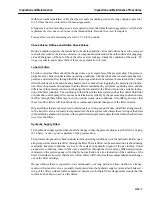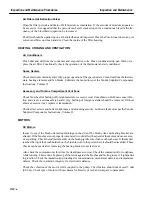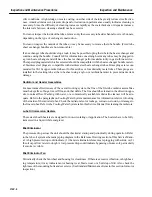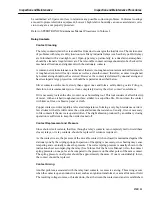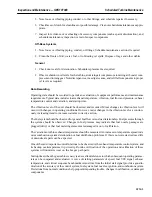
Inspection and Maintenance Procedures
Inspection and Maintenance
IMP–18
CAUTION
Ventilation dampers, automatically closed by a signal
from the fire protection system, must be re-opened before
re-starting the turbine. Failure to do so will shorten the ser-
vice life of the starting motor and reduce generator perfor-
mance.
TEMPERATURE CONTROL
Exhaust Thermocouples (Control and Overtemperature)
Daily reading the exhaust thermocouples will aid in monitoring the combustion system and in detecting
faulty thermocouples. Changes in the combustion system will be detected easily after a normal pattern
of temperature has been established. Diverging temperatures in the exhaust system usually indicate de-
terioration of the combustion chamber, or poor fuel distribution (dirty fuel nozzles). Below normal ther-
mocouple readings indicate thermocouple deterioration. It is important to define a “baseline value” of
exhaust temperature spread with which to compare future data. This baseline data is established during
steady state operation after each of the following conditions:
1. Initial startup of unit
2. Before and after a planned shutdown
3. Before and after planned maintenance
It is important when reviewing exhaust temperature readings to observe any trend which may indicate
deterioration of the combustion system. Gradual and/or sudden temperature excursions should be inves-
tigated as soon as possible to determine validity of readings. Faulty thermocouples should be replaced
as soon as feasible. Refer to the Control Specification drawings for actual exhaust temperature control
settings and allowable spreads.
Wheelspace Thermocouple Temperature Limits
The wheelspace thermocouples, identified together with their nomenclature, are on the Device Summa-
ry. A bad thermocouple will cause a “High Wheelspace Differential Temperature” alarm. The faulty
thermocouple should be replaced at the earliest convenience.
When the average temperature in any wheelspace is higher then the temperature limit set forth in the
table, it is an indication of trouble. High wheelspace temperature may be caused by any of the following
faults:
1. Restriction in cooling air lines
2. Wear of turbine seals
3. Excessive distortion of the turbine stator
4. Improper positioning of thermocouple
Summary of Contents for MS6001B
Page 2: ...Gas Turbine Inspection and Maintenance GEK 107048 I 2 THIS PAGE INTENTIONALLY LEFT BLANK ...
Page 4: ...Inspection and Maintenance Note THIS PAGE INTENTIONALLY LEFT BLANK ...
Page 13: ...INSERT TAB INTRODUCTION ...
Page 14: ......
Page 25: ...INSERT TAB STANDARD PRACTICES ...
Page 26: ......
Page 87: ...INSERT TAB AUXILIARY CONTROLS SYSTEMS MAINTENANCE ...
Page 88: ......
Page 133: ...INSERT TAB SCHEDULED TURBINE MAINTENACE ...
Page 134: ......
Page 157: ...INSERT TAB COMBUSTION INSPECTION ...
Page 158: ......
Page 239: ...INSERT TAB HOT GAS PATH INSPECTION ...
Page 240: ......
Page 313: ...INSERT TAB MAJOR INSPECTION ...
Page 314: ......
Page 316: ...Inspection and Maintenance GEK 107048 Major Inspection 2 THIS PAGE INTENTIONALLY LEFT BLANK ...
Page 363: ...INSERT TAB MAINTENANCE FORMS ...
Page 364: ......


